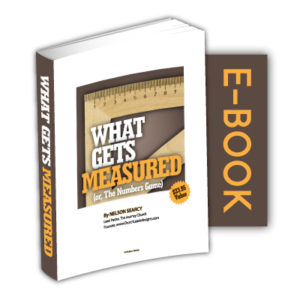 In life, we keep track of numbers for the things that are important to us. We measure birthdays and anniversaries. We make our kids stand against a wall and mark their height each year. We constantly know how much money is in our bank account and how much principal is left on our mortgage. And as my doctor was quick to point out, we (should) keep a close eye on the numbers that correlate to the health of our body. We measure things that matter.
In life, we keep track of numbers for the things that are important to us. We measure birthdays and anniversaries. We make our kids stand against a wall and mark their height each year. We constantly know how much money is in our bank account and how much principal is left on our mortgage. And as my doctor was quick to point out, we (should) keep a close eye on the numbers that correlate to the health of our body. We measure things that matter.
In the same way, we should measure the things that matter within the church. Obviously, we can’t track actual spiritual growth or life transformation with hard numbers, but there are indicators we can track that will let us know whether or not we – and our attendees and members – are on the right course.
Now, I didn’t just wake up one morning and have a revelation about how important numbers are. This was a slow process of realization. My first clue came from the book of Numbers in the Old Testament. The name alone should tell us something.
With further study, I started becoming more and more aware of the emphasis God puts on numerical specificity throughout all of scripture. We know twelve spies went into Canaan – not a handful of spies, but twelve – and ten of them failed to see God’s power and provision. We know that the flood lasted exactly forty days and forty nights. On the day of Pentecost, three thousand were saved.
These are just a few random examples of the scriptures’ careful attention to numbers. There are hundreds more. I couldn’t help but think that if the Bible pays attention to such specific numbers, I should take an interest too. There are indicators we can track that will let us know whether or not we are on the right course.
[bctt tweet=”We should measure the things that matter within the church.” username=”nelsonsearcy”]Another book also played into my thinking about tracking numbers, a secular novel by Michael Lewis called Moneyball. You may have seen the movie version. It takes an in-depth look at the numbers, or statistics, behind baseball. Traditionally, scouts and managers have always weighed a player’s talent by eyeballing his performance on the field. In the book, Lewis makes the case that there is a much better way to see how a player really performs than by sizing him up visually. He argues that by looking at the pattern of a player’s statistics over a period of time, you can know with a high level of certainty whether or not that player is going to succeed in upcoming seasons.
“What gets measured gets done,” but what do you measure each week at your church?
Just as you stay (or should) on top of the numbers that gauge your health, ex: blood pressure levels, weight, and height – The same is true when gauging the health of your church. The numbers are blinking indicators that let you know if all systems are well maintained or if they are in need of improvement.
My FREE “What Gets Measured” E-Book will help you identify the most important numbers in your church and how to use them for maintenance, growth and to spot the places that could need more adjustments.
Here’s what you’ll discover:
- Learn how to measure what matters in your church
- Ways in which natural rhythms develop in these numbers which will help you plan more efficiently in many areas
- How to use numbers as indicators to areas that need improvement
- How to maintain the vital numbers to see continuous growth
- And more!
A lot of times, we take the eyeball approach in our churches, don’t we? We stand on the podium during a weekend service, look out over the crowd, and think, “Well, there are a lot of people here. Whew, we must be healthy.” But what you see on any given Sunday is an illusion.
Under the surface, there could be all kinds of cracks and potential problems you aren’t even aware of yet. Moneyball challenged me to look past the surface-level varnish of our weekly services and really begin to measure how both our short-term and long-term numbers were looking in critical areas. By doing so, we are now able to keep a close eye on the overall health of our church. We can see what’s working, and what’s not.
As you learn to measure what matters and let those numbers speak to you, you will be able to do the same.
Your partner in ministry,
Nelson
Share This Post


